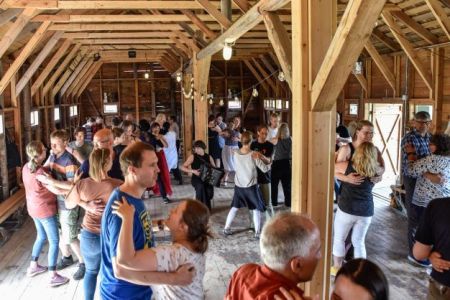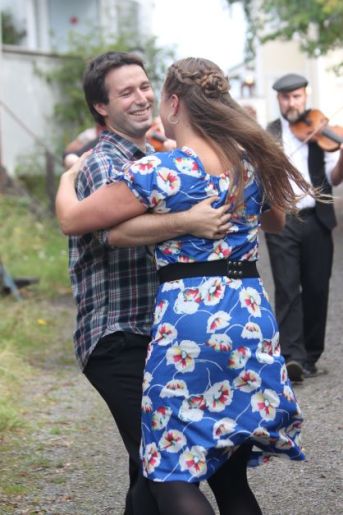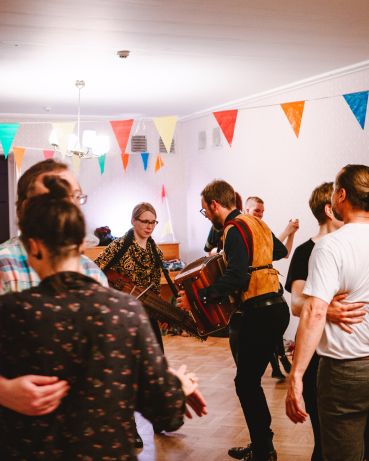Folk partner dancing and dance music
| Folk partner dancing and dance music | ||||
|---|---|---|---|---|
| In the national inventory | ||||
|

Practitioners and people who know the tradition well
Popular folk couple dances and dance music are living forms of cultural heritage and social interaction. In Finland, folk couple dancing refers to the cultural practice of social dancing in pairs, dating back at least to the 17th century. Social dancing in pairs gradually replaced other dance practices and became the predominant form of dancing, continuing as an integral part of Finnish folk dance culture to this day. Dance music, on the other hand, refers to folk music that has evolved to accompany dancing and has been preserved as a living tradition of solo and ensemble playing. Today, this tradition is practiced by hundreds of people, both organized and in smaller private communities. Folk-style couple dancing and dance music are practiced within families and extended families, where it is passed down from one generation to the next. It is also practiced at events, festivals, hobby groups, and as part of various association activities. Some folk dance performance groups also engage in social couple dancing and dance music alongside their performance activities. Organized activities can be found in associations that offer instruction in folk-style couple dancing and dance music or organize social dance events. Instruction can be in the form of courses or workshops, often accompanied by so-called social dances where learned skills can be put into practice.
A diverse and versatile community of dancers and musicians engage in, explore, and teach this combination of dance and dance music. Passionate practitioners within associations are committed to preserving and expanding this tradition. The core group of practitioners consists of both young and adult individuals from all over Finland. In Finland, there are smaller registered associations dedicated to folk-style couple dancing and dance music, as well as club activities where couple dancing and dance music form a part of a larger spectrum of activities. Organizations and institutions in this field include Finlands Svenska Folkdansring, Finlands Svenska Spelmansförbund, Föreningen Brage i Helsingfors, Kansanmusiikki-instituutti, Kansanmusiikin ja Kansantanssin Edistämiskeskus, Kanteleliitto, Karjalainen Nuorisoliitto, Perinnearkku, Pro Kaustinen, Rahvaanmusiikin kerho, Suomalaisen Kansantanssin Ystävät, Suomen Kansanmusiikkiliitto, and Suomen Kansantanssi-instituutin puolesta ry, among others, all of which promote the practice of this tradition.
The tradition is also informally and spontaneously practiced at private gatherings, celebrations, and festivals. Folk music ensembles may perform with the specific intention of providing a space for social couple dancing, fostering a living connection between music and dance. Many performing folk musicians and bands engage in this dance music tradition due to its social and functional demand. Additionally, the tradition is practiced as part of the Finnish social dance culture. Trained music and dance instructors play a role in transmitting and developing this tradition. Higher education-level instruction in Finnish folk dance is offered at Oulu University of Applied Sciences, while higher education-level instruction in folk music is available at the Sibelius Academy of the University of the Arts Helsinki and Centria University of Applied Sciences. Organizations, associations, and institutions also train instructors. Tradition is passed down informally as well, without formal education.
Practising of the tradition
Folk-style couple dancing refers to traditional dance styles that are danced lively and spontaneously, with free variations. These dance styles include masurkka, polka, waltz, schottische, polska, hambo, and jenkka, among others.
The situation of folk-style couple dancing and dance music requires both musicians and dancers to come together. These events combine live music with informal, tradition-based couple dancing. The key is the lively and interactive connection between the music and dance. People engage in couple dancing voluntarily, driven by their social needs. Folk-style couple dancing and dance music can emerge without external guidance, in which case there is no formal instruction or dance caller; the space adapts to the presence of those involved. On the other hand, the tradition is also practiced in situations where dances are taught to others. Often, instructional situations prepare dancers for informal dances.

Even though folk-style couple dances can be self-directed, created by the dancing couple in the moment, the rhythm and movement are strongly rooted in tradition. The music played provides each dance style with a distinct rhythm, and there are traditional basic steps. Depending on the experience, courage, and creativity of the dancing couple, learned dance steps are modified, or entirely new movement combinations are created while still fitting the dance style dictated by the music.
In the best situations, dancers inspire musicians just as much as musicians inspire dancers. Skilled dancers guide musicians with their dance and its nuances, while accomplished musicians motivate movement through the quality of their playing.
This phenomenon exists in various forms throughout Finland, with events spontaneously arising in connection with folk music and dance events. Occasions for practicing the tradition are also organized regularly or irregularly in different locations by active enthusiasts. Families and extended families also uphold the tradition within their own circles.
Masters of the tradition can execute free, improvisational dancing and playing where each participant claims space and gives space to others. This skill can be taught at its simplest by starting with walking-based movements. Learning also occurs in informal dance situations without adopting strict roles of teacher and student. In today's dance culture, there is a move towards a more conversational form of couple dancing, where traditional patterns and roles can adapt. Dance can also be carried out in a structured form based on established dance patterns while allowing for variations within those patterns. In modern times, there is no longer a binary, normative division of dancers into male/female roles. Instead, tradition practitioners are encouraged to embrace principles of creating safer spaces and follow them. The goal is to invite people of all kinds to participate, ensuring the tradition remains vibrant.
Some tradition practitioners describe dancing and playing as an integral part of their identity. The threshold for dancing is low because they have grown up in a culture of social dancing. They have experienced that practicing the tradition can provide them with a connection to others, joy, social capital, and meaning in life.
The background and history of the tradition
The history of couple dancing and dance music is often explained as separate forms of expression, even though in the contemporary view, folk-style couple dancing and dance music are seen as one phenomenon.
In the origin stories of folk musicians, there is no information suggesting that they ever started practicing specifically to become dance musicians or wedding musicians. Instead, exceptional talent in playing music led them to become wedding musicians. The tradition of dance music has been passed down from one generation to the next, often following the apprentice-master principle. For example, according to the accounts of South Ostrobothnian musicians born between 1880 and 1940, there was always a musician playing at events where people danced. Children would listen to the musician throughout the evening, sitting on the railing of a bridge, on the threshold of a barn, on a bench in the living room, or on a table, and they would carefully memorize what the musician played. During these musical moments, the musicians' gestures, expressions, movements, stillness, melodies, silences, actions, emotions, and values were also conveyed. Gradually, the observations in the children's minds became habits and practices.
When the dance music the children heard shifted from polska to polka and eventually to accordion jazz, the children's musical environment changed. Simultaneously, role models, values, norms, and sources of identification changed. In South Ostrobothnia, for instance, these changes occurred very slowly and at different times in various parts of the region. The tradition of dance music was strongly transmitted through role models, and even as role models shifted from the neighbor's musician to jazz orchestras heard on the radio, the inclination of children to seek sources of identification in the tradition remained present. Until the late 18th century, couple dances were based on movement that occurred in a specific location within the dance space. Dancing couples could spin, perform various movement sequences facing each other, or switch places, but they did not move extensively within the space. The concept of movement in the dance space became progressive and began to change significantly in the 19th century. The principles of movement changed as well. In 19th-century couple dances, couples usually moved around the dance space and rotated to some extent while dancing together. Typically, they danced counterclockwise, which is now referred to as the "dance direction." Couples also rotated clockwise. Other movement and rotation directions were also in use.

The transition to dances newer than polska and minuet was firmly established in Finnish dance culture during the 19th century. Along with American couple dances, these new dances virtually replaced all other dance forms at public dance events by the early 20th century.
During the 20th century, ballroom dances became the mainstream couple dance, gradually pushing aside the folk tradition, until folk couple dances were consciously revitalized and experienced a resurgence. Nowadays, folk musicians can jam with folk music, whereas earlier, musicians had a specific prepared dance repertoire.
Dance is an integral part of society. In the 21st century, structural changes within folk-style couple dancing also reflect changes in society. A dance couple is no longer defined strictly as a man and a woman; in the 21st century, the concepts of leader and follower are emphasized, or other non-gendered terms are used. The roles within the dance couple are flexible, and dancing is more conversational, as opposed to adhering to strong role divisions. In the early 2000s, solo dancing emerged as a strong trend within folk dance culture, alternating with dancing as a couple for over two decades. It is now understood that music and dance equally depend on each other.
The transmission of the tradition
Dance and musical skills are passed down through shared occasions of dancing and playing music together. Learning is not solely the responsibility of teachers; the entire dance and music community, with a significant role for peer learning, contributes to the process. Trained music and dance instructors serve as tradition bearers and developers. Organizations, associations, and institutions of adult education provide training for instructors. Tradition is transmitted from one generation to the next by bringing people together for dance and music through various courses, events, and training sessions. To support the transmission of tradition, videos of folk couple dancing and music are also created. Often, individuals become involved in practicing the tradition as children through family activities. In addition to organized activities, tradition is also passed down from generation to generation. Besides family circles, tradition thrives in various events, such as the Kaustinen Folk Music Festival, where children and young people are exposed to practicing tradition through participation. Dance and music traditions naturally become part of life in various ways.
Today, tradition is transmitted, for example, through events like the Nordic Dance Helsinki club nights, which are held once a month. The Hailuoto Folk Couple Dance Retreat, which lasts for a weekend, gathers people interested in the fusion of folk couple dancing and music together annually. In Helsinki, organizations like the Student Folk Dancers (Opiskelijakansantanssijat) and Perinnearkku hold jams once a month, while in Oulu, it's the North Ostrobothnia Folk Music Association (Pohjois-Pohjanmaan Kansanmusiikkiyhdistys). The Orivesi All Stars Folk Music Orchestra operates nationwide and introduces musicians to playing both traditional and contemporary dance music. Additionally, weekly lessons in folk couple dancing and dance music are organized in course formats throughout Finland. Dance house activities have developed since the 1990s, revitalizing folk couple dancing. Projects like "Koko Suomi osaa Sottiisia" (The Whole of Finland Knows Sottiisi) funded by the Finnish Heritage Agency, the ambassadors of folk couple dancing as part of the project, the Dance Invitation annual theme by the Folk Music and Folk Dance Promotion Center, and the KanTaMus digital pedagogy project have been instrumental in passing down tradition in the 2020s.
In some instances, precise oral tradition information about how the tradition was passed down in the past is not available. Tradition has been passed on through dance and music publications. When moving beyond source material like sheet music, recordings, and dance notations into older material, tradition is constructed, and its content is imagined.
The future of the tradition
Traditionally, folk dance and folk music have been more distinct from each other due to Western artistic perceptions, which have unnecessarily separated different art forms like dance and music. In Western societies, the relationship between dance and music, if addressed at all, has often been seen as functional. Music has been considered a prerequisite for dance, yet still treated as something entirely separate.
However, in the future and in the present, efforts are being made to reunite these art forms into one shared tradition, one art form. Despite the prevailing individualism in society - or perhaps because of it - the popularity of folk couple dances, as well as folk dances in general, has been growing since the 2010s. One aspect of the first joint cultural policy program for folk music and folk dance in Finland, called VISIO2025, focuses on bringing the fields of folk music and folk dance closer together. It seems that creating this vision has had an impact, as the convergence of folk couple dancing and dance music is particularly evident.
Unlike many other traditional practices, folk couple dancing and dance music are not threatened by the aging of practitioners. Finland invests in the education of children and young people in folk music and folk dance through national camps, events, and initiatives such as the Näppäri program, which reaches hundreds of children.
As mentioned earlier, today's dancers are no longer categorized in binary and normative terms. Instead, practitioners of tradition are encouraged to explore principles of a safer space and abide by them. This is a strength of folk dance and folk music in the present day and is likely to attract an increasingly diverse range of participants to the tradition.
The community/communities behind this submission
Pohjois-Pohjanmaan Kansanmusiikkiyhdistys ry
Bibliography and links to external sources of information
Videos
Kokkola TV - Kaisu Försti, Muusikko, Evijärvi. Mestaripelimanni vuodelta 1980 kertoo tanssin säestämisestä.
Online sources
SottiisiMoves 2020 – Saa tanssia!
Antero Vipunen - haja-ajatuksia kansantanssista. Suomalaisen kansanomaisen tanssin historia pähkinänkuoressa 3: varsinaiset paritanssit (keskeneräinen käsikirjoitus).
Practitioners web pages
KamuKanta - kansanmusiikin ja kansantanssin tietoa yhteenkeräävä sivusto
KanTaMus – Kansantanssin ja kansanmusiikin digipedagogiikka
Oulun ammattikorkeakoulun tanssinopettajan koulutusohjelma
Taideyliopiston Sibelius-Akatemian kansanmusiikin aineryhmä
Centria-ammattikorkeakoulun musiikkipedagogin koulutusohjelma
Bibliography
Asplund, Hoppu, Laitinen, Leisiö, Saha, Westerholm. 2006. Kansanmusiikki.toim. Kerola-Innala, P & Lönnroth, Maasala, Valkama, Wessman. WSOY.
Talvitie-Kella, Tuuli. 2008. Soittaja oppijana. Vuosina 1880–1940 syntyneiden eteläpohjalaisten soittajien ensikosketukset musiikkiin ja soittamiseen. Kasvatus & Aika 2 (2), 7–28. https://journal.fi/kasvatusjaaika/article/view/68154
Talvitie-Kella, Tuuli. 2010.Hääpolskasta haitarijatsiin : 1900-luvun alun tanssimusiikkikulttuuri eteläpohjalaisten tanssisoittajien kertomana, kokemana ja soittamana.
Paula Kettu & Jutta Wrangén. HIVUTTAUDU JA HYTKY! Kansanomaisten paritanssien kehitys nykymenneisyydessä ja nyt
Petri Hoppu. Tanssi ja musiikki - yhdessä vai erikseen?
Marko Tikka & Seija-Leena Nevala: Kielletyt leikit – Tanssin kieltämisen historia Suomessa 1888-1984
